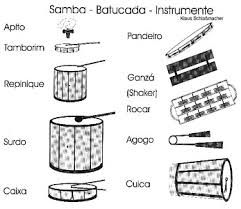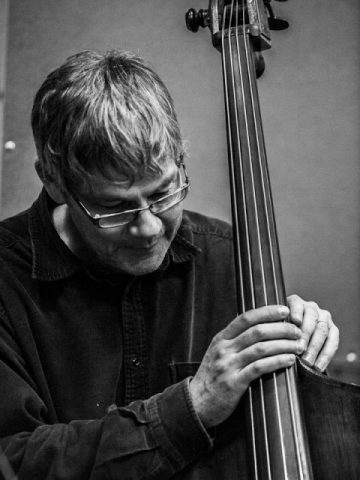Category Archives: Grade 6/7 Music
Pearl Brazilian Percussion Line: Cuica
A-Star Metal Double Agogo Bells
Samba – Batucada – Instruments

Amazing Bateria Batucada
Samba Percussion
Brazilian Percussion Instruments
Brazilian Instruments & Rhythms
Brazilian Drums
Brazilian Drums more in detail:
The Tambourim – The smallest brazilian drum is the tambourim which is a small frame approximately six inches in diameter around with a plastic head. The Tambourim is held in left hand with thumb across the rim and remaining fingers curled inside to support the instrument. It is struck with a plastic stick, sometimes many small sticks bound together. To get the best tone, strike the Tambourim slightly off center. When struck, the Tamborim produces a very distinct and somewhat piercing sound.
Pandeiro – The pandeiro is a one-of-a kind of tambourim that has a single head with jingles around the rim that accentuate the strikes. It is made of wood and 5 sets of jingles. The player holds the pandeiro in his weaker hand and then plays it by striking with the thumb, fingertips and the whole hand. The pandeiro can produce such a range of low, medium and high timbres and variety of sounds that it is widely considered ‘the complete percussion instrument’.
Surdo – The surdo is a large double-headed bass drum made with stainless steel or wood shell and is perhaps the most distinguishable of all of the other samba instruments, because of its deep loud sound providing the main fundamental beat of the samba rhythm. The Surdo suspended from the player’s neck by a strap and is played with a soft-headed stick and a bare hand or with two sticks. The free hand is used to open and close the sound of the drum. To produce the most significant sound of Surdo drums, strike them in the center. Surdo are the largest drums used but there are of 3 different sizes small, medium and large (most commonly used) to create different pitch and rhythm in beats.
The Repinique – The tenor drums in bacteria are called Repinique. They help complement and expand the Surdo beats. It is also suspended from the neck with a strap. Played with one stick and a bare hand, or with two flexible plastic sticks, the repinique is a small, double-headed drum measuring approximately 12” in diameter by 12” deep that is tuned very high. The free hand is used for muffling or slapping strokes by striking the drums across the rim and head simultaneously. The shell is usually made of stainless steel or some other metals with plastic heads. The head is tensioned tight enough to produce that distinguishing sound of this instrument. It is always tuned so high that it produces a tone which cuts through the sound of all the other instruments of the bateria. It is usually the lead of bacteria, signaling breaks and starts and can also be used as solo instrument.
Cuica – The cuica is a single-headed Brazilian friction drum. Sound is produced in cuica drums by rubbing a thin, short and carved wooden cane attached to the membrane on the inside of the instrument. It produces a very distinct sound and has an exceptional pitch range. A thin wooden stick is attached in the center of the drum head, reaching into the drum’s interior. It is also suspended from the neck with a strap and is held under one arm at chest height. The body is made of metal and it is also very popular as a solo instrument.
Caixa – The caixa is a small snare drum or the side drum, but has a much dryer and lighter sharp tone when the head is struck with drum sticks. The caixa also suspended from the neck with a strap is played at waist level using two sticks or can also be kept on stand to be played by seated drummer. It is usually the central piece of a drum set and is used in Brazilian percussion music or samba to provide supporting rhythms which carry the music forward and make it swing. The caixa is made of two heads, both of plastic along with a clatter of metal wires on the bottom head which is called the snares.
Atabaque – The atabaque is a tall, wooden hand congo drum. The head is made of animal skin and the shell is made of traditional jacaranda wood from Brazil. They are around 46” tall when standing and the playable head surface is 10” in diameter. A succession of ropes are tied or intertwined around the body, which connects a metal ring at the base of the drum to the head. The atabaque is used in marshal arts/dance/game of Capoeira, Maculelê and the Afro-Brazilian religion of Candomble.
Samba History
Music of the People
Samba is a Brazilian music style of infectious rhythm and complex origins. It developed as urban music in the late 19th and early 20th centuries in the favelas, or slums, of Rio de Janeiro. Its roots, however, trace back hundreds of years to customs and traditions brought to Brazil by African slaves. Many of these slaves first came to Bahia, a region in northeastern Brazil along the Atlantic Ocean. Bahia, first settled by people of Portuguese descent, became an important area for growing sugarcane between the years 1500 and 1700. Vast cane plantations developed, and traders forcibly brought peoples from Africa to Bahia to work on the plantations and harvest the crops.
So, samba is considered music of the common people. Its roots come from old Bahian music and dance styles, like the lundu and jongo, which connect back to the African slaves. When descendants of these men and women moved to Rio, most of them settled in specific neighborhoods in the favelas, bringing their distinctive music with them. The original form of samba is called samba de morro (morro means hill, and alludes to the slums located on Rio’s hillsides). It usually includes an improvised verse sung by a soloist, followed by a choir.
Growing Popularity
Much like the beginnings of jazz in America, when samba first developed in Brazil, it was looked down upon by the middle and upper classes as uncivilized and wild. Eventually, though, everyone became captivated by it. Many early samba composers were anonymous, but as the music’s popularity increased, composers and musicians became stars. They were aided by two technologies that enabled samba to be heard throughout America: the development of LP records and radio.
In the 1920s, samba became increasingly radio-friendly, with more melody than percussion. It also developed a different format, featuring an instrumental intro, then a verse and chorus, and finally, a choro band (which plays an improvised style similar to ragtime). This variation evolved into a new type of samba, called a samba-canção, which is slower and almost always romantic in nature.
Samba is festive dance music and it is used in many types of ways. For example, it plays a huge role in Brazilian Carnival celebrations. Like Mardi Gras in New Orleans, Carnival is a huge party that takes over the streets in the week or so leading up to Lent. As an outgrowth of samba’s connection to Carnival, samba schools developed in Rio, dedicated to performing samba and dancing during the festivities. These schools are very similar to clubs, where people gather, rehearse, and prepare elaborate musical presentations for Carnival. The first samba school opened in 1928, and more than 100 of them exist today.
